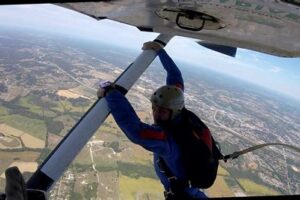Table of Contents
Curious about skydiving fatalities? Discover the answer to the question how many people die skydiving in this informative article. Gain insights into the safety statistics and risk factors associated with this thrilling adventure sport.
When it comes to extreme sports, skydiving is often considered one of the most exhilarating and adrenaline-pumping activities. However, the question that lingers in the minds of many is just how safe is this thrilling adventure? While the idea of jumping out of an airplane thousands of feet above the ground may seem daunting, it is essential to understand the reality of the risks involved. Exploring the statistics and examining the safety measures can shed light on the question: How many people die skydiving?
Skydiving: A Thrilling Adventure
Skydiving is an exhilarating and adrenaline-pumping activity that attracts adventurers from around the world. It offers an unparalleled sense of freedom as you soar through the sky, defying gravity. However, as with any extreme sport, there are inherent risks involved. One of the most pressing concerns among potential skydivers is the number of fatalities associated with this thrilling adventure. In this article, we will explore the statistics and shed light on how many people die while skydiving.
Understanding Skydiving Fatalities
Before delving into the numbers, it’s essential to comprehend how skydiving fatalities are defined. A skydiving fatality refers to a death resulting from an accident or mishap that occurs during a skydiving jump or related activities. These fatalities are typically categorized as either student fatalities (involving individuals who are participating in their first few jumps) or experienced fatalities (involving seasoned skydivers with significant training and experience).
The Importance of Safety Measures
Safety measures play a crucial role in reducing the number of fatalities in skydiving. Skydiving centers and organizations worldwide adhere to strict protocols and guidelines to ensure the safety of their participants. These include meticulous equipment checks, thorough training programs, and continuous monitoring of weather conditions. The implementation of safety measures significantly mitigates potential risks and helps minimize the number of fatalities.
Statistics and Figures
While skydiving fatalities do occur, it’s important to note that the rate of fatality has been decreasing over the years. According to the United States Parachute Association (USPA), there were a total of 11 fatal skydiving accidents in 2020 out of approximately 2.67 million jumps. This equates to a fatality rate of 0.41 per 100,000 jumps. It is worth mentioning that these figures include both experienced and student fatalities.
Comparing Skydiving to Everyday Activities
Contrary to popular belief, skydiving is not as dangerous as some may assume. In fact, statistics reveal that skydiving is relatively safer than several common activities we engage in regularly. For instance, driving a car carries a significantly higher risk of fatality, with an annual death rate of around 12.4 per 100,000 drivers. Furthermore, even activities such as swimming or cycling have higher fatality rates when compared to skydiving.
Factors Influencing Fatality Rates
Several factors can influence the fatality rate in skydiving. One prominent factor is the experience level of the jumper. Novice skydivers tend to be more susceptible to accidents due to their limited training and exposure to various scenarios. Additionally, weather conditions and equipment malfunctions can also contribute to accidents. However, the implementation of stringent safety measures and continuous training helps mitigate these risks, ensuring a safer skydiving experience.
The Importance of Proper Training
Skydiving centers prioritize proper training to ensure the safety of all participants. The training programs typically include comprehensive ground instruction covering safety procedures, equipment usage, body positioning, and emergency protocols. Additionally, students are required to complete a certain number of jumps under the supervision of qualified instructors before becoming certified skydivers. This rigorous training significantly reduces the chances of accidents and fatalities.
Continual Improvement and Awareness
The skydiving community is continually striving to enhance safety standards and minimize the risk of accidents. Organizations like the USPA conduct regular safety audits and provide educational resources to both novice and experienced skydivers. These initiatives promote awareness and facilitate knowledge-sharing within the community, ensuring that all participants are equipped with the latest safety information.
Conclusion: Embracing Adventure Responsibly
While skydiving does come with inherent risks, it is important to approach the activity responsibly and be aware of the safety measures in place. The number of fatalities associated with skydiving has been decreasing steadily, thanks to effective safety protocols, improved training, and increased awareness. By adhering to proper training and guidelines, skydiving enthusiasts can continue to enjoy this thrilling adventure while minimizing the risk of accidents and ensuring their safety.
Introduction to Skydiving Fatalities
Skydiving, an exhilarating adventure sport that involves jumping from an aircraft and freefalling through the air before deploying a parachute, is enjoyed by thousands of people worldwide. However, it is crucial to understand the inherent risks involved in this thrilling experience.
Understanding the Statistics
When analyzing the number of deaths related to skydiving, it is important to consider the statistical data available. According to the United States Parachute Association (USPA), an organization that oversees skydiving in the country, the number of fatalities from skydiving accidents is relatively low compared to other activities.
Accurate Records and Reporting
Accurate record-keeping is crucial for assessing the safety of any activity, including skydiving. The USPA maintains a comprehensive database of all skydiving-related incidents, allowing for a detailed analysis of fatalities and their causes.
Common Causes of Skydiving Fatalities
While skydiving is generally considered safe when proper procedures are followed, tragic accidents can still occur. Common causes of skydiving fatalities include improper parachute packing, equipment malfunctions, errors in judgment during the jump, and mid-air collisions.
Training and Safety Measures
To mitigate the risks associated with skydiving, extensive training programs are in place to ensure participants possess the necessary skills and knowledge to carry out a safe jump. These programs focus on teaching proper parachute deployment, emergency procedures, and how to handle potential hazards during a jump.
Risk Factors and Pre-existing Conditions
Although skydiving carries inherent risks, certain pre-existing medical conditions or factors can significantly increase the likelihood of an accident. It is vital for skydivers to openly communicate any medical conditions with their instructors and undergo thorough medical assessments to ensure their suitability for the sport.
Ongoing Safety Improvements
The skydiving community is consistently focused on improving safety measures to reduce the number of fatalities. Advanced equipment, rigorous training standards, and constant evaluation of incident data help identify areas of improvement and allow for the implementation of safety protocols.
Weighing the Risks and Rewards
Understanding the risks involved in skydiving is necessary for anyone considering participating in the sport. It is crucial to weigh the potential dangers against the exhilaration and sense of achievement that skydiving brings, ensuring informed decisions are made to maximize safety and minimize risks. Remember, with proper training, adherence to safety protocols, and responsible practices, the risks associated with skydiving can be significantly reduced.
From a professional standpoint, it is important to address the topic of skydiving fatalities and provide an accurate perspective on the number of people who die while participating in this extreme sport. While skydiving is undoubtedly an exhilarating and adrenaline-fueled activity, it is not without its risks. However, it is crucial to analyze these risks objectively and put them into proper context.
When considering the fatality rate associated with skydiving, it is essential to understand that the sport has significantly evolved over the years. With advancements in equipment, training techniques, and safety protocols, the overall safety of skydiving has improved significantly. As a result, the number of fatalities has decreased over time.
Here are some key points to consider:
- Skydiving fatality statistics should be evaluated in terms of incidents per participant, rather than as an absolute number. When calculated this way, the risk associated with skydiving becomes relatively low.
- According to statistics provided by the United States Parachute Association (USPA), the average fatality rate for skydiving in the United States is approximately one fatality per 250,000 jumps. This statistic reflects the continuous efforts made by professionals in the industry to improve safety standards.
- The majority of skydiving accidents occur due to human error or negligence, such as failure to follow proper procedures, inadequate training, or pushing personal limits beyond skill level. These incidents can be minimized through comprehensive training programs, strict adherence to safety protocols, and ongoing education within the skydiving community.
- It is worth noting that tandem skydiving, where a student is attached to an experienced instructor, has an even lower fatality rate than solo skydiving. This is primarily because the instructor assumes the responsibility for the jump and ensures all safety procedures are followed.
- Lastly, it is crucial to understand that the thrill of skydiving often outweighs the perceived risks for many individuals. Skydiving is a well-regulated sport with strict safety guidelines and inspections. Professional skydiving centers prioritize safety above all else and continuously invest in improving equipment and training programs.
In conclusion, while skydiving does present inherent risks, the fatality rate associated with this extreme sport has significantly decreased over time. By following proper safety protocols, receiving thorough training, and making responsible decisions, individuals can minimize these risks even further. It is important to approach skydiving with a professional mindset, acknowledging the risks involved while also recognizing the strides made in ensuring the safety of participants.
Thank you for taking the time to visit our blog and explore the fascinating world of skydiving. We hope that you have found our articles informative and engaging, providing you with valuable insights into this thrilling activity. As we conclude our discussion on skydiving, we would like to address a question that often arises in conversations about this extreme sport: how many people die skydiving?
First and foremost, it is crucial to note that while skydiving carries inherent risks, it is generally considered a safe activity when proper precautions are taken. Skydiving centers around the world adhere to strict safety regulations and guidelines to minimize the likelihood of accidents. However, as with any adventure sport or recreational activity, accidents can happen, and unfortunately, fatalities do occur.
Statistically speaking, the fatality rate in skydiving is relatively low. According to the United States Parachute Association (USPA), there were 13 fatal skydiving accidents out of approximately 3.3 million jumps in 2019, resulting in a fatality rate of 0.004%. While every loss of life is tragic, these numbers indicate that the risk of dying while skydiving is minimal. It is also important to consider that the majority of skydiving accidents are attributed to human error rather than equipment failure.
While discussing the statistics may provide some reassurance, it is crucial to remember that each skydiving fatality represents a person who tragically lost their life pursuing their passion. Every incident serves as a reminder to approach this high-adrenaline sport with respect, caution, and proper training. Prioritizing safety by choosing reputable skydiving centers, ensuring equipment is well-maintained, and following all instructions from experienced instructors can significantly reduce the risk of accidents.
In conclusion, although there is a small risk associated with skydiving, the number of fatalities is relatively low when compared to the large number of jumps performed annually. With proper precautions and responsible decision-making, skydiving can be a thrilling and safe adventure. We hope that our blog has provided you with valuable information and insights into the world of skydiving. We encourage you to explore further, continue learning, and perhaps even take the leap into the exhilarating realm of skydiving yourself!
Thank you once again for joining us on this journey, and we look forward to sharing more exciting topics and experiences with you in the future. Stay safe, stay curious, and keep exploring!
Video How Many People Die Skydiving
Here are some common questions that people also ask about skydiving fatalities:
-
How many people die skydiving?
On average, there are an estimated 0.006 skydiving fatalities per 1,000 jumps, which translates to a fatality rate of approximately 0.6%. However, it’s important to note that this statistic can vary depending on various factors such as experience level, equipment quality, weather conditions, and adherence to safety protocols.
-
What are the main causes of skydiving deaths?
The primary contributors to skydiving fatalities are usually human error and equipment malfunction. Mistakes made during the jump, failure to deploy the parachute correctly, or issues with the parachute system itself can lead to accidents. However, it is worth mentioning that skydiving is a highly regulated sport, and safety measures have significantly reduced the risks over the years.
-
Is skydiving safer than driving?
Statistically speaking, skydiving is considered to be less safe than driving. However, it’s important to note that this comparison can be misleading due to the vast difference in exposure time. While the risk of a fatal accident may be higher in skydiving, the overall time spent skydiving is significantly less compared to the time spent driving on roads.
-
Can you increase your chances of survival while skydiving?
Absolutely! By taking proper training, following all safety guidelines, and using well-maintained equipment, you can significantly increase your chances of a safe skydiving experience. It is crucial to choose a reputable skydiving center with experienced instructors and to always prioritize safety above all else.
-
What precautions are taken to prevent skydiving accidents?
The skydiving industry takes safety very seriously and has implemented numerous precautions to prevent accidents. These include rigorous training programs for both instructors and participants, frequent equipment inspections, strict adherence to safety protocols, and continuous monitoring of weather conditions to ensure safe jump operations. Additionally, the use of automatic activation devices (AADs) in parachutes adds an extra layer of safety by automatically deploying the reserve parachute if necessary.
It’s important to remember that while skydiving does carry inherent risks, with proper training, preparation, and adherence to safety guidelines, it can be a thrilling and relatively safe activity.






